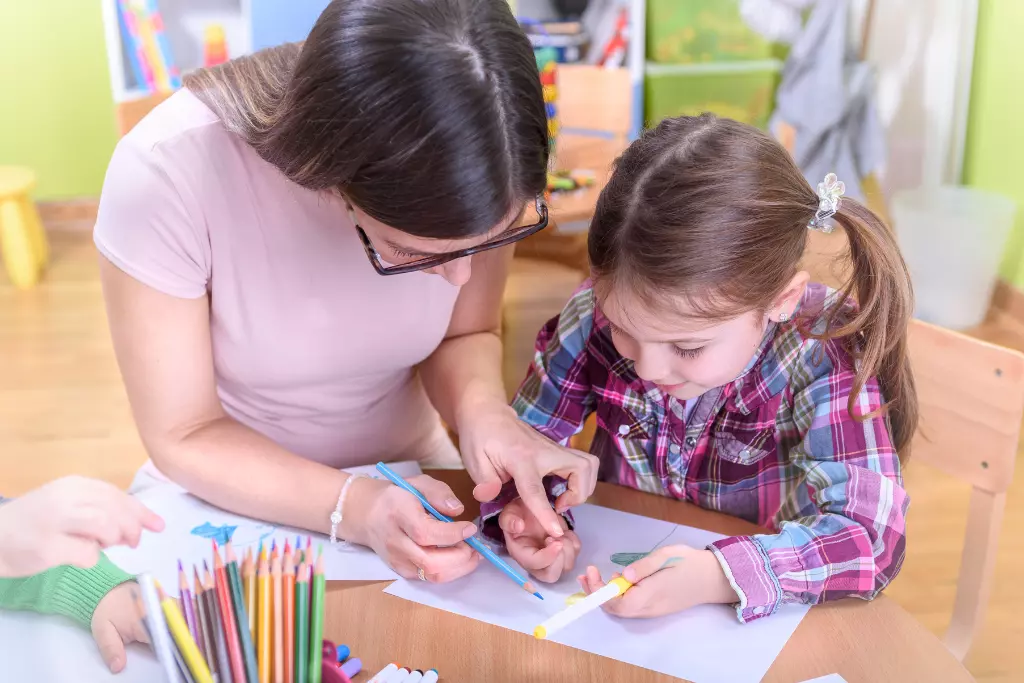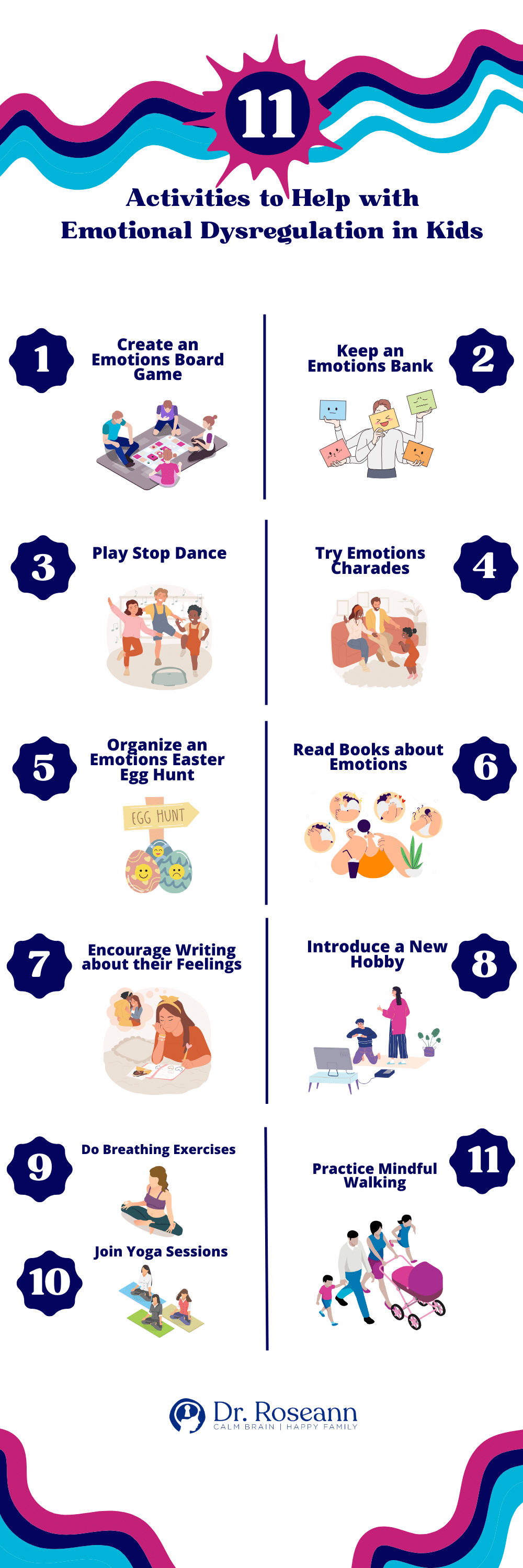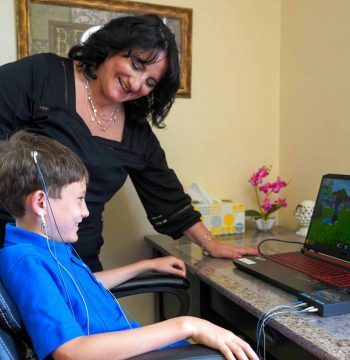11 Emotional Regulation Activities for Children
Healthy emotional regulation means understanding and managing one's emotions. Children can easily handle difficult situations when they can regulate their emotions. These kids tend to be more resilient. In addition, they are less prone to getting upset or overwhelmed. Their healthy coping strategies will help them feel calmer and more in control. That is why emotional regulation activities can help, especially when there is an interfering clinical issue.
Many children with ADHD or attention deficit hyperactivity disorder experience emotional dysregulation. Though emotional dysregulation is excluded from the standard diagnostic criteria, it is nevertheless a common and troubling feature of ADHD. Examples of emotional regulation issues in children are excessive anger, mood swings, irritability, sensitivity, and intense feelings.
Treatment for ADHD can sometimes ease these emotional symptoms, but it does not restore emotional balance or improve attention. Building emotional resilience is necessary to achieve a remarkable improvement in this area.
To achieve better emotional stability, children with ADHD should learn coping strategies, meet their basic health needs, and seek professional interventions. In addition, consulting with an experienced clinical psychologist can help them learn critical skills like executive functioning and emotional intelligence.
Understanding Emotional Regulation in Kids
Individuals are said to be emotionally regulated when they recognize and control their emotions and respond appropriately to varying social settings. They are self-regulated and that shows up in their actions.
Children learn about emotional regulation and self regulation in a variety of ways. Watching how others react and behave consistently in certain situations teaches children these essential skills.
Engaging children in activities and using tools to help them regulate their emotions are necessary if they have difficulty recognizing and controlling their own. In addition, there are a lot of fun activities that can help improve emotional regulation while keeping children engaged.
Regulating emotions is very important for children as they grow up. It is as important as excelling academically and learning social-emotional skills. A child's emotional regulation impacts their physical and mental health. Additionally, it can adversely affect their problem-solving skills, relationships, and productivity.
Additionally, emotional regulation helps individuals to manage anxiety and stress, establish boundaries, develop empathy, and handle challenging situations. It is more likely that these kids will have a higher level of self-confidence, especially if they learn how to regulate emotions at a young age.
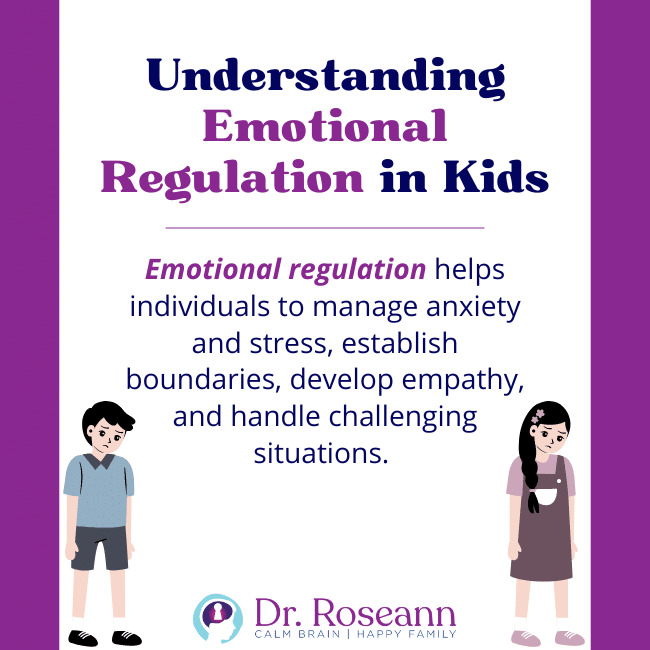
Emotional Regulation at Every Developmental Level
Emotion regulation activities can easily be incorporated into family fun for young children, school-aged kids or teens. Heck, they even help adults to emotionally regulate!
Whether building skills at home or supporting self regulation skills for students, emphasis should focus on:
- Identifying and labeling emotions
- Practicing problem-solving
- Building stress tolerance
- Developing coping skills
- Adding in brain calming methods
- Explicit reinforcement of desired emotional regulation behaviors
With emotional skills/regulation activities for toddlers, think about playful activities that teach young children how to pump the brakes. Getting off of devices and learning though play is important. Emotional regulation activities for kindergarten kids or any younger child should focus on identification of a range of emotions beyond frustration, as many kids who struggle with emotion regulation just don't have the right words.
When it comes to emotion regulation activities for kids that are school-aged, there is a two-pronged focus. Focus should continue on feelings indentification but they needs more practice with problem-solving. Real world practice and learning metacognitive skills will help them to not only self regulate emotions but be able to manage stress as they age.
Teens who struggle with emotional regulation often have a situational stressor, a clinical issue or never developed good self-regulation skills. Emotional regulation activities for teens need to occur at home but also they may need support at school or from a licensed therapist.
Emotional regulation activities with adults can foster less reactivity and greater calm. Learning how to co regulate with a child, will not only force you to be less reactive and more in control of your stressors, it will give your dysregulated child that calm that their nervous system is craving. One mom in our program said to me, “If I can't regulate my emotions, then my daughter is off the wall. It wasn't until I began to focus on my own nervous system, that I could see her emotionally regulate.”
Some adults benefit from DBT emotion regulation activities because it focuses on stopping looping and intrusive thoughts. DBT emotion regulation skills take time and persistence because it works to counter a lifetime of negative thoughts.
If you are unsure of how to regulate so your child can co-regulate off of you, starting with natural anxiety solutions is your next step. Proven stress and anxiety reducing methods such as magnesium, breathwork, mindfulness, and PEMF calm your dysregulated brain down enough where you can focus on learning new, healthy coping skills, as well as building resilience. s
Emotional Regulation Activities For Kids: Countering Emotional Dysregulation
When a skill is weak in any area for a child, they need explicit reinforcement of the desired skill in order to build it. Just like if one was weak in math, we would put extra time and attention around that weaker math skill in order to learn it. The same should and can be done for kids who struggle with emotional-regulation.
Managing emotions for kids and social emotional learning may feel like a full-time job when your child has emotional control issues and you don't have the right guidance to support those “big emotions.” There is a way to support the development of positive emotions.
Here are some fun ideas that can help young children process their own emotions and have a great time doing so. These activities can help them learn important skills while understanding more about a wide range of emotions and big feelings that they may be experiencing for the first time.
1. Create an Emotions Board Game
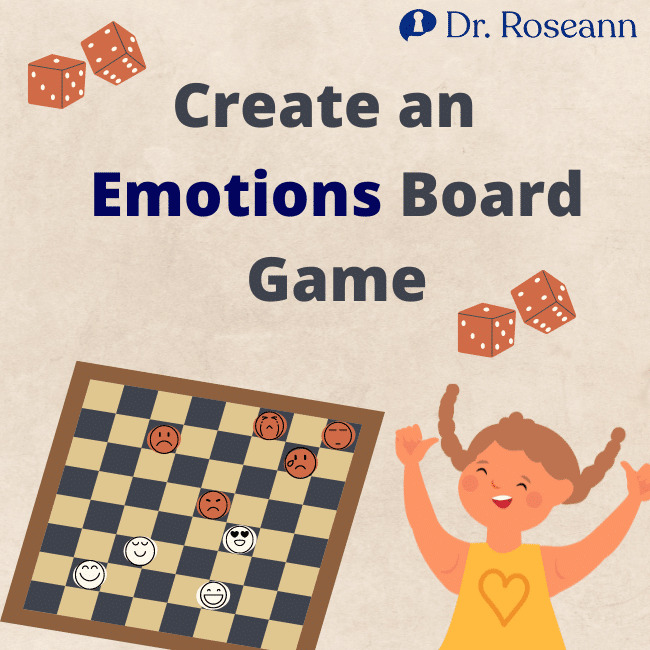
The first step to playing this fun game is to create a board full of feelings and emotions for kids to use as reference. You'll need a symbol or small photo to correspond with each feeling or emotion on the board.
The general idea is for the child to visualize each feeling or emotion you're trying to teach them. Your child may find it difficult to recognize certain emotions, so include them in varying intensities on the board. For example, the board can include different anger or sadness levels if your child has trouble coping with or recognizing these emotions.
Doing so will help them relate to these feelings, especially when they experience emotional outbursts. Examples of emotions to put on the board are happiness, excitement, anger, annoyance, nervousness, anxiousness, embarrassment, frustration, loneliness, confusion, boredom, and overwhelm.
The next step is to create a stack of cards containing different situations. Each card must describe a variety of situations that require specific emotional reactions. Through this game, the child learns to recognize feelings and which emotional states require particular responses.
2. Keep an Emotions Bank
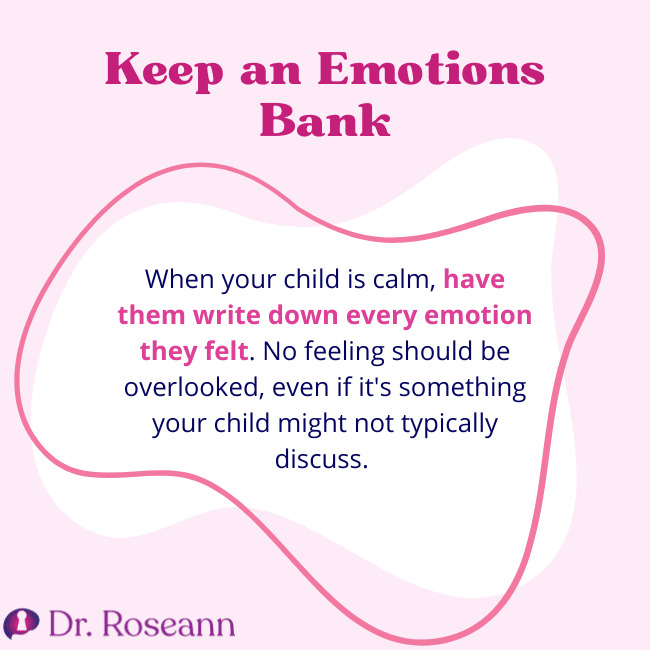
When your child is calm, have them write down every emotion they felt. No feeling should be overlooked, even if it's something your child might not typically discuss. After your child has listed each emotion, have them list all physical sensations associated with each.
Discuss each emotion, especially the emotions your child has problems regulating. Show them alternative ways to act. Put that list somewhere they'll often see it and be reminded of the appropriate way to act.
Continue to add to this list for a month or more. It is best to complete this activity gradually over time instead of doing it all at once, which can sometimes result in overwhelm. Additionally, your child might only remember how they felt during a specific situation once they experience it again.
These practices will help to manage emotions, especially big emotions, but develop lifelong social emotional skills.
3. Play Stop Dance
Self-control is also closely related to emotional regulation, like managing one's physical or emotional state. Physical activity is a safe and effective way to counter an activated limbic brain.
This game allows children to improve their emotional regulation skills in a fun and healthy way, even if they play it only for several minutes.
What seems to be a simple game can help emphasize how important it is to control their bodies and even their emotions. Exercise also builds executive functioning skills and supports neurotransmitters. You only need music that can be paused and restarted frequently. Young children may find this game more enjoyable if they play with their siblings or parents.
All participants should dance or move when the music is playing. But s soon as the music stops, they should freeze and be quiet. This game emphasizes the contrast between acting silly when dancing and being serious while in freeze mode.
It will further help them address the differences between emotional states and practice impulse control in different scenarios. Additionally, this game improves their gross motor skills. It also teaches them to control their emotions and self-regulate as they switch from dancing to freezing.
Play fast-tempo and slow songs and ask the players to increase or decrease their pace of movement accordingly. Doing so exposes a child to stimuli in a fun way. It is an excellent game for regulating big emotions. To control emotions, a child must react to external inputs and triggers, such as movement breaks. That's where this game can help.
4. Try Emotions Charades
Charades is one of my favorite emotional regulation games. It not only is fun but helps kids in a non-defensive way to identify and role play emotions. This can be very helpful when your deeply feeling kid is very sensitive.
Observing other people's emotions is also essential to improve your ability to regulate them. The easiest way to do this is to watch the people around you. You will get the same impact by modifying the classic games of charades, where emotions are acted out with visual cues for older children to identify.
Someone has to act out different emotions for the child, and this game can be played silently or with sound effects. However, starting the game in silent mode allows the child to focus harder on identifying the physical markers associated with emotions and feelings. As the child enjoys guessing the different emotions, it also reinforces the physical attributes of these emotions.
5. Organize an Emotions Easter Egg Hunt
Add eyes and a mouth to Easter eggs to make various faces. Use plastic toys with interchangeable parts. Interchanging the parts to make different facial expressions helps children learn about different emotions, as well as builds fine motor skills.
Then, like a real Easter egg hunt, hide the plastic eggs in certain areas. Give them clues as to where they can find them. This way, the child also learns problem-solving alongside emotion regulation skills.
When your child finds an egg, let them determine which emotion is shown on it. Help them identify which negative emotions they are comfortable expressing or having problems regulating. Group the eggs in the basket accordingly, paying attention to the difficult emotions that require regulation.
6. Read Books about Emotions
Your child can learn about different feelings and emotions by reading them books. For example, one study shows that children with higher language proficiency had better emotional competency test results (Kumschick et al., 2014). In addition, you can find books that teach children how to recognize specific emotions.
7. Encourage Writing about their Feelings
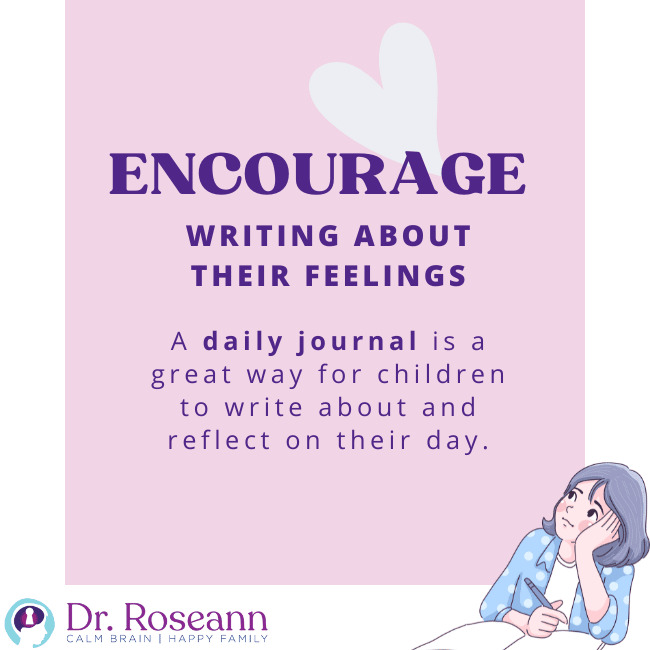
A daily journal is a great way for children to write about and reflect on their day. Aside from emotional regulation, this activity can also teach children time management and improve their working memory.
One study shows that journaling is a great tool that can reduce mental distress, improve well-being, and enhance physical functions. Adding it to a person's daily medical care can help improve their quality of life (Smyth et al., 2018).
8. Introduce a New Hobby
Older kids with emotional regulation issues can benefit greatly from a new hobby. You should introduce your child to a new creative endeavor. The arts, music, and dance are some of the best ways to express and share emotions in tangible ways. According to one study, music and dance can trigger aesthetic and emotional responses (Dieterich-Hartwell, 2019).
9. Do Breathing Exercises
As an essential part of emotional regulation, breathing exercises help calm and center oneself. Stress, anxiety, and anger cause a person's breathing to become shallow and rapid. Children can benefit from basic breathing exercises to help them regulate their strong emotions.
Deep breathing exercises can calm your child down if they feel overwhelmed quickly. Taking deep breaths can reduce the intensity of most emotional situations. In addition, one study shows slow breathing helps synchronize brain waves, improving communication (Saha, 2023).
10. Join Yoga Sessions
Teaching kids calming poses in yoga shows them how to regulate their intense emotions. Aside from increasing oxygen flow to their brains, yoga activities also reduce the production of stress hormones and improve one's mood. Additionally, they boost resilience and self-confidence.
A growing body of research shows the positive effects of yoga on increasing one's emotional self-esteem, self-regulation, and emotional awareness. It also improves physical well-being by decreasing stress, anger, anxiety, and depression (Janjhua et al., 2020).
11. Practice Mindful Walking
Daily mindful walks are an excellent way to incorporate mindfulness. This exercise will help kids stay focused. It will also clear their minds and get them up and moving. Encourage your kids to walk with you around the neighborhood.
One study on mindfulness practice revealed that mindful walking for four weeks could reduce psychological distress compared to no intervention. Stress reduction can be achieved through mindfulness training and physical exercise (Teut et al., 2013).
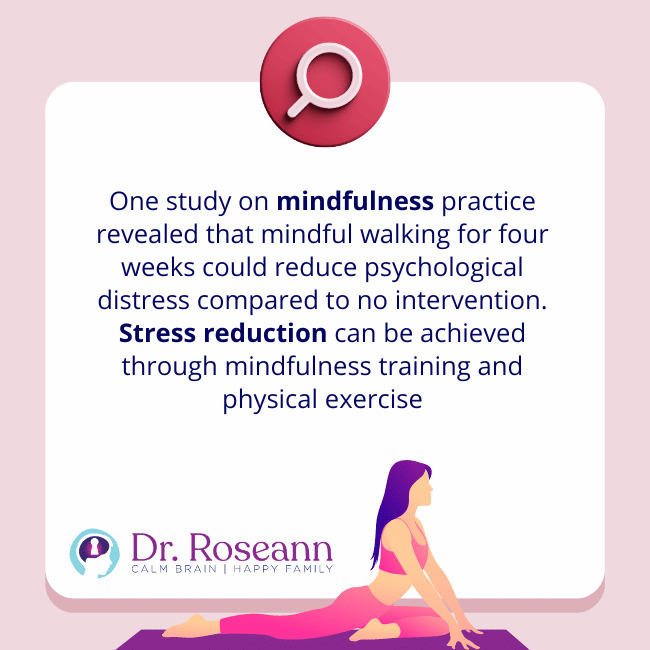
Emotional Regulation Activities and The Developing Brain
There are many factors that influence the development of emotional regulation skills including temperament, role modeling of skills, emotional intelligence, and having clinical issues such as ADHD, autism, learning issues, OCD, mood disorders, anxiety, PANS or PANDAS, and so on. These issues interfere with how they learn.
Zones of regulation activities help kids of all ages distinguish between activated and non-activated states, so keep communication open and flowing. Identifying feeling zones and helping them to pair it with body sensations is a key component to regulating emotions. Zones of regulation calming strategies give your child the tools they need to self regulate emotions and behaviors.
Remember, co-regulation techniques and emotional regulation activities only work when you actually use them. So, now you know how to help an emotionally dsyregulated child, choose an activity and try to be as present as possible.
Citations:
Dieterich-Hartwell, R. M. (2019). Music, movement, and emotions: an inquiry with suggestions for the practice of dance/movement therapy. Body, Movement and Dance in Psychotherapy, 1–15. https://doi.org/10.1080/17432979.2019.1676310
Janjhua, Y., Chaudhary, R., Sharma, N., & Kumar, K. (2020). A study on effect of yoga on emotional regulation, self-esteem, and feelings of adolescents. Journal of Family Medicine and Primary Care, 9(7), 3381. https://doi.org/10.4103/jfmpc.jfmpc_153_20
Kumschick, I. R., Beck, L., Eid, M., Witte, G., Klann-Delius, G., Heuser, I., Steinlein, R., & Menninghaus, W. (2014). READING and FEELING: the effects of a literature-based intervention designed to increase emotional competence in second and third graders. Frontiers in Psychology, 5. https://doi.org/10.3389/fpsyg.2014.01448
Pratt, R. R. (2004). Art, dance, and music therapy. Physical Medicine and Rehabilitation Clinics of North America, 15(4), 827–841. https://doi.org/10.1016/j.pmr.2004.03.004
Saha, N. (2023, January 13). Review and meta-analysis suggest breathwork may be effective for improving stress and mental health. News-Medical.net. https://www.news-medical.net/news/20230113/Review-and-meta-analysis-suggests-breathwork-may-be-effective-for-improving-stress-and-mental-health.aspx?mibextid=Zxz2cZ
Smyth, J. M., Johnson, J. A., Auer, B. J., Lehman, E., Talamo, G., & Sciamanna, C. N. (2018). Online Positive Affect Journaling in the Improvement of Mental Distress and Well-Being in General Medical Patients With Elevated Anxiety Symptoms: A Preliminary Randomized Controlled Trial. JMIR Mental Health, 5(4), e11290. https://doi.org/10.2196/11290
Teut, M., Roesner, E. J., Ortiz, M., Reese, F., Binting, S., Roll, S., Fischer, H. F., Michalsen, A., Willich, S. N., & Brinkhaus, B. (2013). Mindful Walking in Psychologically Distressed Individuals: A Randomized Controlled Trial. Evidence-Based Complementary and Alternative Medicine, 2013, 1–7. https://doi.org/10.1155/2013/489856Emotional Regulation Activities
Always remember… “Calm Brain, Happy Family™”
Are you looking for SOLUTIONS for your struggling child or teen?
Dr. Roseann and her team are all about science-backed solutions, so you are in the right place!
Grab your complimentary copy of
147 Therapist-Endorsed Self-Regulation Strategies for Children: A Practical Guide for Parents
There are 3 ways to work with Dr. Roseann
Dr. Roseann is a Children’s Mental Health Expert and Licensed Therapist who has been featured in/on hundreds of media outlets including The Mel Robbins Show, CBS, NBC, PIX11 NYC, Today, FORBES, CNN, The New York Times, The Washington Post, Business Insider, Women’s Day, Healthline, CNET, Parade Magazine and PARENTS. FORBES called her, “A thought leader in children’s mental health.”

She coined the terms, “Re-entry panic syndrome” and “eco-anxiety” and is a frequent contributor to media on mental health.
Dr. Roseann Capanna-Hodge has three decades of experience in working with children, teens and their families with attention-deficit hyperactivity disorder (ADHD), autism, concussion, dyslexia and learning disability, anxiety, Obsessive Compulsive Disorder (OCD), depression and mood disorder, Lyme Disease, and PANS/PANDAS using science-backed natural mental health solutions such as supplements, magnesium, nutrition, QEEG Brain maps, neurofeedback, PEMF, psychotherapy and other non-medication approaches.
She is the author of three bestselling books, It’s Gonna Be OK!: Proven Ways to Improve Your Child's Mental Health, The Teletherapy Toolkit, and Brain Under Attack. Dr. Roseann is known for offering a message of hope through science-endorsed methods that promote a calm brain.
Her trademarked BrainBehaviorResetⓇ Program and It’s Gonna be OK!Ⓡ Podcast has been a cornerstone for thousands of parents facing mental health, behavioral or neurodevelopmental challenges.
She is the founder and director of The Global Institute of Children’s Mental Health, Neurotastic™Brain Formulas and Dr. Roseann Capanna-Hodge, LLC. Dr. Roseann is a Board Certified Neurofeedback (BCN) Practitioner, a Board Member of the Northeast Region Biofeedback Society (NRBS), Certified Integrative Mental Health Professional (CIMHP) and an Amen Clinic Certified Brain Health Coach. She is also a member of The International Lyme Disease and Associated Disease Society (ILADS), The American Psychological Association (APA), Anxiety and Depression Association of America (ADAA) National Association of School Psychologists (NASP), International OCD Foundation (IOCDF).
© Roseann-Capanna-Hodge, LLC 2023
Disclaimer: This article is not intended to give health advice and it is recommended to consult with a physician before beginning any new wellness regime. *The effectiveness of diagnosis and treatment vary by patient and condition. Dr. Roseann Capanna-Hodge, LLC does not guarantee certain results.

